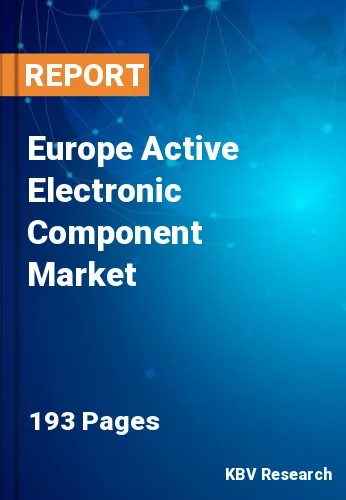The Europe Active Electronic Component Market would witness market growth of 6.2% CAGR during the forecast period (2023-2030). In the year 2020, the Europe market's volume surged to 580.2 million units, showcasing a growth of 5.1% (2019-2022).
Graphene, a single layer of carbon atoms, has exceptional electrical conductivity and mechanical strength. Graphene-based transistors, sensors, and energy storage devices are being explored for various applications. Beyond graphene, other 2D materials like transition metal dichalcogenides (TMDs) are gaining attention. TMDs have unique electronic properties and are used in transistors, sensors, and optoelectronic devices.
Moreover, ferroelectric materials can switch polarization in response to an electric field. Ferroelectric transistors are being investigated for non-volatile memory and neuromorphic computing applications. Spintronics, or spin transport electronics, harness the spin of electrons in addition to their charge. Spintronics components are explored for applications like magnetic sensors and non-volatile memory. PICs combine optical and electronic components on a single chip, enabling high-speed data transmission and processing for data centres, telecommunications, and quantum computing applications.
The human brain inspires neuromorphic electronics and aims to create electronic components that can process information in a brain-like manner. These components are used in artificial intelligence and machine learning applications. Organic semiconductors made from organic materials offer flexibility and low manufacturing costs. Organic electronic components are used in flexible displays, sensors, and organic solar cells.
The automotive industry of Poland is one of the biggest in Europe. This industry's main export successes are vehicle bodywork, electric buses, trailers, and batteries. In terms of the value of exported goods, Poland's main partners in this industry are Germany, Italy, and France. In 2021, industry exports accounted for 4.5% of Polish goods exports. As a result, there will be an increased demand for active electronic components in the Europe region.
The Germany market dominated the Europe Active Electronic Component Market by Country in 2022 and would continue to be a dominant market till 2030; thereby, achieving a market value of $22,338.6 million by 2030. The UK market is exhibiting a CAGR of 5.3% during (2023 - 2030). Additionally, The France market would experience a CAGR of 7% during (2023 - 2030).
Based on Product Type, the market is segmented into Semiconductor Devices (Integrated Circuits (ICs), Transistors, Diode, Optoelectronics), Vacuum Tube, Display Devices and Others. Based on End User, the market is segmented into Consumer Electronics, Networking & Telecommunication, Manufacturing, Aerospace & Defense, Automotive, Healthcare and Others. Based on countries, the market is segmented into Germany, UK, France, Russia, Spain, Italy, and Rest of Europe.
Free Valuable Insights: The Global Active Electronic Component Market will Hit $477.7 Billion by 2030, at a CAGR of 6.4%
The market research report covers the analysis of key stake holders of the market. Key companies profiled in the report include Technologies AG, Advanced Micro Devices, Inc., STMicroelectronics N.V., Microchip Technology, Inc., Analog Devices, Inc., Broadcom Inc., NXP Semiconductors N.V., Intel Corporation, Texas Instruments, Inc., Toshiba Corporation, Skillsoft Corporation.
By Product Type (Volume, Million Units, USD Million, 2019 to 2030)
By End User (Volume, Million Units, USD Million, 2019 to 2030)
By Country (Volume, Million Units, USD Million, 2019 to 2030)
Our team of dedicated experts can provide you with attractive expansion opportunities for your business.

